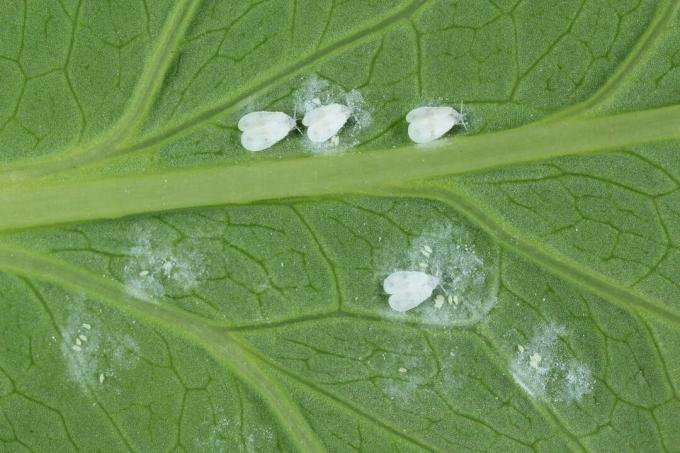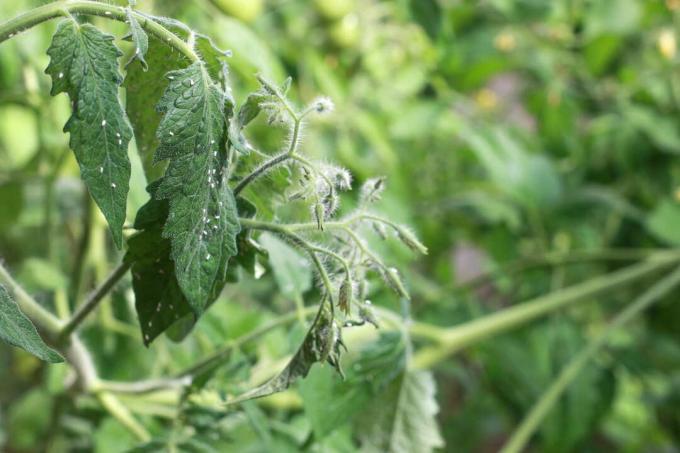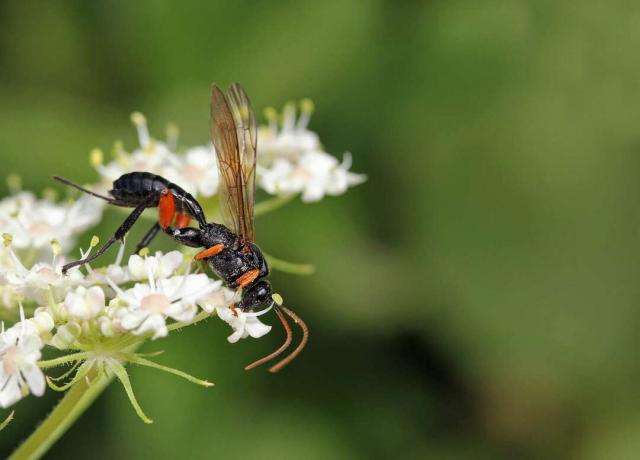Small white flies on house plants and in the garden are just a nuisance. We reveal which home remedies help and how you can fight whiteflies naturally and biologically.

The term "white fly" is a common name for various whiteflies from the family of Aleyrodidae. Like the aphids, they are counted among the plant lice. The two most important pests known as "whitefly" in home gardens are the cabbage whitefly (Aleurodes proletella) and the greenhouse whitefly (Trialeurodes vaporariorumThese two most common whiteflies have many things in common, including similar appearance and life cycle. But there are also quite a few differences, which we will show you in this article with the help of the correct species names.
contents
- Whitefly: Wanted poster
- This is how you can recognize the damage caused by the whitefly
-
These plants attack the white plant pests
- Whitefly on cabbage
- Whitefly on tomatoes
- Whitefly on house plants
-
Fight whitefly
- Biologically control whiteflies
- Home remedies for whitefly
- Further control options for whitefly
- Preventing whitefly
Whitefly: Wanted poster
Unsurprisingly, whiteflies are better known as the whitefly. These are small flies, about two millimeters in size, powdered white. Because of their rapid reproduction, they are, like aphids, very feared pests. From the egg through several larval stages to the reproductive fly, it only takes several weeks at favorable, warm temperatures. This rapid development results in several generations of white flies over the course of the growing season, which lay many new eggs every day.
Larvae cause the greatest damage. Like aphids, they remove sap from the host plants. The valuable proteins are filtered out of the plant sap and a large part of the carbohydrate-rich phloem juice is excreted in the form of honeydew. Honeydew sticks the leaves together and provides a perfect breeding ground for sooty mildew. These hinder the photosynthesis of the plant by growing on the leaves, which are soiled with honeydew, but without penetrating the plant. In addition, the whitefly can also be a vector for plant viruses if it has recently sucked on a virus-infected wild plant, for example. Some of these plant viruses are very harmful to the plant, some of them simply reduce its beauty - and unfortunately cannot be combated.
So often the whitefly infestation and its nutrition at the expense of the plant is not the biggest problem. Rather, sooty mildew or viral diseases can cause much greater damage. The main infestation times are late summer and autumn, as large populations are already at work at this time. In warm early summer, the infestation shifts forward.

This is how you can recognize the damage caused by the whitefly
To spot whitefly, you have to inspect the underside of the leaves of potential host plants. Because both adult animals and larvae are well hidden on the underside of the leaf and the eggs are also deposited there. A characteristic feature of the white-yellow eggs of the whitefly is that they are deposited in a ring on the underside of the leaf. After hatching, the whitish to yellow-green-brownish larvae are initially mobile, in later larval stages they then settle in a pox-like manner. Often flies about two millimeters in size as well as various larval stages and eggs can be seen on the underside of the leaves. When the plant is touched, the adult insects fly away in an arc. The small insects are enveloped by a wax dust. Therefore, another characteristic of an infestation is the white dust on parts of the plant, the potting soil and of course the small white insects. A sticky coating suggests honeydew excretions - if it is discolored black, sooty fungi have already settled.
You can recognize an infestation by whitefly by the following symptoms:
- Two millimeters large, white, winged insects
- Ring-shaped deposit of white-yellow eggs on the underside of the leaf
- White dust on parts of plants or the potting soil
- Sticky coating on the leaves and any sooty fungi on them

These plants attack the white plant pests
Often referred to as whitefly, the species of whitefly prefer different host plants. In our gardens, most of the damage occurs to tomatoes and cabbage vegetables.
Whitefly on cabbage
The cabbage scallop attacks all cabbage vegetables. Cauliflower, broccoli, savoy cabbage, green and Brussels sprouts are particularly popular. The adult flies can overwinter on Brussels sprouts and then quickly build up new populations in spring. But even removing cabbage plants over the winter does not guarantee that whiteflies will not appear in the next year. Adult whiteflies also find other cruciferous vegetables (Brassicaceae), such as winter rape, to hibernate in winter.
Whitefly on tomatoes
Tomatoes are attacked by whiteflies much more frequently in the greenhouse than in the field. The warm and humid conditions in the greenhouse are especially ideal for the greenhouse whiteflies. They are not fussy and infect numerous types of vegetables such as tomatoes, cucumbers and zucchini.

Whitefly on house plants
The greenhouse moth scale particularly likes to attack indoor plants. The evenly warm temperatures as well as the lack of predators give these whiteflies optimal conditions for reproduction in the apartment. The whitefly targets different houseplants, but the poinsettia (Euphorbia pulcherrima) infested.
Fight whitefly
A strong infestation of the whitefly can severely damage the laboriously planted and cared for vegetables in the home garden. Both the damage caused by sucking in the sap and the infestation of sooty fungi and the spread of viruses can only be reduced by combating the whitefly.
Biologically control whiteflies
Whiteflies are an annoying plant parasite, but synthetic pesticides are not necessary to combat them. We always recommend choosing a biological method, especially in the home garden and in the apartment.
Neem-based preparations are an environmentally friendly and very effective way of combating whiteflies. The neem oil from the seeds of the neem tree contains the active ingredient azadirachtin, which is absorbed by the insects when they suckle on the plant. The whitefly larvae are hindered in their development by neem preparations and the whitefly disappears. Our Plantura Organic pest-free neem is based on this highly effective and purely herbal active ingredient from the neem tree. The active ingredient is absorbed by the insects when they suckle and ensures that they quickly stop their sucking activity. The agent is simply mixed with water and the emulsion is sprayed onto infested plants with a spray bottle. Precise information on the dosage and use of Organic pest-free neem can be found on the product packaging. With Plantura Bio-Pest-Free Neem you can also successfully prevent other biting, leaf-mining and sucking insects, for example Fight aphids, of course. Our organic pest-free neem can be used both in the home and in the garden and is also not dangerous for bees. Please note that our organic pest-free neem must be used exactly as specified in the application recommendation in order to rule out undesirable effects.

Summary: Biologically control whitefly
- Mix organic pest-free neem with water according to the package insert
- Apply the emulsion to the affected plant with a spray bottle
- Young shoots are protected by the systemic effect and do not have to be treated afterwards
- White flies are completely killed after two weeks at the latest
In addition, agents based on rapeseed oil or orange oil can be used to combat whitefly. The oil prevents an adequate supply of oxygen to the insects and causes them to die. Rapeseed oil supplements also kill eggs that have come into contact with the oil. However, some soft-walled plant leaves do not tolerate these agents as well.
Home remedies for whitefly
If you have a slight whitefly infestation, you can also use home remedies. A common home remedy for plant lice is nettle stock. Since whiteflies belong to the plant lice, nettle brew can also be used against them. Here, 500 grams of fresh nettles are brewed with five liters of boiling water. The cold brew can then be sprayed onto the infected plant several times a day.
A soapy solution made from 30 grams of potash soap or 200 milliliters of soft soap in one liter of water can also be applied to the infected plant several times a day. We recommend covering the soil around the infected plant with a thick cloth so that too much soap does not get into the soil.

Further control options for whitefly
Synthetic pesticides are also available to combat whitefly. Active ingredients such as acetamiprid not only damage whitefly, but unfortunately also beneficial insects in your garden, which is why we recommend natural measures. Whitefly pesticides can also contain plant pyrethrins. However, these active ingredients are also harmful to beneficial insects. We therefore advise against using them.
Another environmentally friendly measure in the event of a slight infestation is yellow glue boards. These can be placed near infested plants and their yellow color attracts whiteflies, which stick to the boards. You should only use the yellow glue traps indoors or in a greenhouse because of their yellow color bees or other useful insects can also be attracted and these then also stick would. Basically serve Yellow panels However, the early detection of the insects rather than the control and are only sufficient in a few cases.
Fighting whitefly successfully:
- Agents based on neem oil are effective and environmentally friendly, for example our Plantura Organic pest-free neem
- Preparations based on rapeseed oil are suitable for hard-leaved plants
- Home remedies such as nettle stock and soapy water can help with mild infestation
- Yellow glue boards can help with a slight infestation in the interior or indicate the infestation

Preventing whitefly
You can prevent whitefly infestation with a few tricks: Whiteflies are smelled by the smell of some plants - for example thyme (Thymus), Basil (Ocimum basilicum), Sage (Salvia officinalis) and Tagetes (Tagetes) - expelled. You can use this and place plants that have already been infested next to these plants that give off their scent. You can also see flowering native wild herbs such as chervil (Anthriscus sylvestris) to plant in your garden. These blooming herbs attract beneficial insects such as parasitic wasps, which fight whiteflies. Our Plantura beneficial insect magnet is a mixture of seeds with beneficial insects promoting plants and offers you the possibility to promote beneficial insects in your garden in a simple way.
An optimal supply of your plants with nutrients is important, both outdoors and in living spaces, so that pests do not have an easy time of it. Fertilizers tailored to the plant will help you meet the nutritional needs of your plant. We recommend that you ensure a good supply of potassium and calcium for stable cell walls and fertilize organic nitrogen, which is gradually released. Our Plantura organic fertilizer enable you to fertilize needs-based outdoors and in your home.
A bright and well-ventilated location for your plants in the living room in particular has a preventive effect against infestation by whitefly. This enables them to grow vigorously and to be more resilient.

Summary: preventing whitefly
- Use strongly scented plants in the immediate vicinity
- Promote beneficial organisms in the garden
- Optimal nutrient supply for the plants
- Indoor bright and well-ventilated location for healthy plants
You can find more natural remedies against annoying plant pests in our Shop for plant protection & insect repellent Find.
